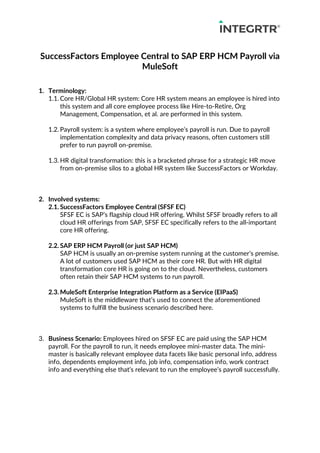
SuccessFactors Employee Central to SAP ERP HCM Payroll via MuleSoft
- 1. SuccessFactors Employee Central to SAP ERP HCM Payroll via MuleSoft 1. Terminology: 1.1. Core HR/Global HR system: Core HR system means an employee is hired into this system and all core employee process like Hire-to-Retire, Org Management, Compensation, et al. are performed in this system. 1.2. Payroll system: is a system where employee’s payroll is run. Due to payroll implementation complexity and data privacy reasons, often customers still prefer to run payroll on-premise. 1.3. HR digital transformation: this is a bracketed phrase for a strategic HR move from on-premise silos to a global HR system like SuccessFactors or Workday. 2. Involved systems: 2.1. SuccessFactors Employee Central (SFSF EC) SFSF EC is SAP’s flagship cloud HR offering. Whilst SFSF broadly refers to all cloud HR offerings from SAP, SFSF EC specifically refers to the all-important core HR offering. 2.2. SAP ERP HCM Payroll (or just SAP HCM) SAP HCM is usually an on-premise system running at the customer’s premise. A lot of customers used SAP HCM as their core HR. But with HR digital transformation core HR is going on to the cloud. Nevertheless, customers often retain their SAP HCM systems to run payroll. 2.3. MuleSoft Enterprise Integration Platform as a Service (EIPaaS) MuleSoft is the middleware that’s used to connect the aforementioned systems to fulfill the business scenario described here. 3. Business Scenario: Employees hired on SFSF EC are paid using the SAP HCM payroll. For the payroll to run, it needs employee mini-master data. The mini- master is basically relevant employee data facets like basic personal info, address info, dependents employment info, job info, compensation info, work contract info and everything else that’s relevant to run the employee’s payroll successfully.
- 2. Image: Business case All new employees and all payroll relevant changes must be transferred to the payroll system on a pre-ordained time interval for effective payroll runs. It’s therefore imperative that the SFSF EC and SAP HCM are connected via a middleware process flow. 4. Technical Architecture: SFSF EC offers a SOAP API called Compound Employee API (CE API). CE API offers employee data that includes changes in the past, present and the future and it can do so based on a plethora of WHERE clauses like country, company, dates, employee number, etc. On the SAP side, the ABAP add-on PA_SE_IN provides an inbound web service that’s responsible for handling employee data coming in from SFSF. The MuleSoft process in the middleware has to query the CE API data for the latest changes, transform it to a format permissible in SAP and call the inbound service on ABAP. The overall integration architecture can be broken down into the following five steps. 1. An ABAP report (a program that can be scheduled) on SAP HCM, called by a cronjob, wakes up to make a call to SFSF EC to fetch the latest employee changes. This report is already a part of the SAP add on PA_SE_IN. 2. The ABAP report calls an outbound proxy to relay the select statement to an HTTP Listener on Mulesoft CloudHub/On-premise. The query is basically requesting for employee data from SFSF. Sample query: <QueryString> SELECT address_information,alternative_cost_distribution,compensation_information,depe ndent_information,employment_information,job_information,national_id_card,pay
- 3. compensation_non_recurring,paycompensation_recurring,payment_information,p erson,personal_information from CompoundEmployee WHERE replicationTargetSystem = 'ERPCLNT200' AND replicationContentType = 'EMPLOYEE_MASTER_DATA' AND person_id_external IN ('1000','1001') AND company_territory_code IN ('DEU') AND selectFromDate = to_date('2019-01- 01','yyyy-MM-dd') AND isContingentWorker IN ('0') AND effective_end_date >= to_date('2019-01-01' )</QueryString> Image: Data flow architecture. 3. The HTTP LISTENER on Mulesoft responds to this call and invokes the whole message flow. The mule flow transforms the incoming select statement, requests the API on EC for the latest employee data and sends it back to ERP. Image: A screengrab from the message flow on MuleSoft is provided here.
- 4. 4. On ERP, the inbound proxy receives the data from the mule flow. 5. The proxy class updates the SAP Infotypes with the latest data from EC. The proxy class is also a part of the SAP standard add-on PA_SE_IN. 5. Integrtr Template: Integrtr has developed a mule flow (screenshot above) that customers can directly use in their integration scenarios with simple configuration. Customers can import it to their tenant/landscape, configure it and they’re good to go. It’s a glue that works in tandem with SAP’s integration add-on PA_SE_IN. 6. Conclusion: SuccessFactors and SAP HCM, the latter often considered old and obsolete – wrongfully so, offer excellent HTTP based APIs that are secure and granular. Whilst an Employee Central to SAP HCM integration is best solved with SAP Cloud Platform Integration, often customers have stick to their known, pre- existing middlewares. And gluing them together, as we’ve shown it, is in fact not so difficult at all. About integrtr GmbH: We're an Integration Lifecycle Management company always hungry for complex integration challenges - irrespective of the IPaaS at play. Do write to us at sales@integrtr.com for a free demo of the aforementioned integration to help you make an informed decision. Disclaimer: All other trademarks cited herein are the property of their respective owners.
